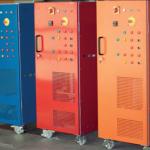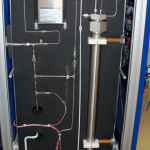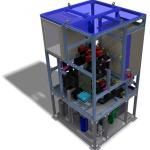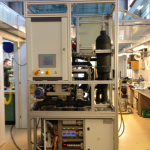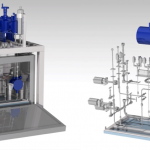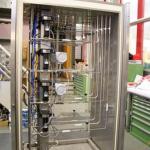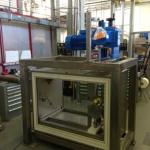Using CO2 for detector cooling - an innovative approach
 Carbon Dioxide (CO2) is today the reference choice for the thermal management of most of the future vertex and tracking detectors requiring low temperature operation at LHC.
Carbon Dioxide (CO2) is today the reference choice for the thermal management of most of the future vertex and tracking detectors requiring low temperature operation at LHC.
This natural refrigerant, often referred to under the official name of R744, finds increasing use in the refrigeration industry because it is non-toxic, non-flammable, non-ozone-depleting and environmentally friendly. Besides the important safety and ecological considerations, what makes it so attractive for application to silicon trackers is its superior combination of thermo-fluid dynamics properties, allowing a significant reduction of the detector’s material budget due to the use of smaller pipes and less insulation. The cost of the cooling system’s installation and operation are lower if compared to today’s technologies.
The use of CO2 for the low temperature cooling of detector electronics has been pioneered at NIKHEF at the beginning of the 2000’s for the Silicon Tracker of the AMS02 experiment at the ISS (International Space Station) and for the VELO vertex detector of the LHCb experiment at CERN. The focus for detector cooling plants is on stable operation temperature and simple and reliable control of the conditions at the detector (the plant’s evaporator) with control equipment positioned in remote and easily accessible locations (usually in the experiment’s service cavern). With these objectives in mind, the NIKHEF engineer Bart Verlaat developed a new approach for application in AMS and LHCb using CO2 as a secondary refrigerant in a pumped two-phase cooling system, called 2-PACL, for “2-Phase Accumulator Controlled Loop”.
The smooth, effective and reliable operation of these systems over years is a remarkable visit card for this innovative approach towards a possible wider use in HEP detectors. When the PH Department decided to launch a project on Detector Cooling within the PH-DT group in 2009, it was just a natural choice to define CO2 detector cooling as one of the main investigation lines for the coming LHC detector upgrade programmes. In collaboration with NIKHEF and the ATLAS and CMS experiments, the design and construction of a CO2 pilot plant was launched. The plant, named CORA for “CO2 Research Apparatus”, directly derived from the design developed for the LHCb VELO and Cryolab of the AT Department. CORA was completed in 2010 and it is available for CO2 cooling studies since then. Building on this first experience and on the successful LHCb VELO operation, the resistance to introduce high pressure piping required by CO2 operation into delicate and expensive tracking detectors rapidly started to decrease.
At the end of 2010, a strong combined effort of the PH-DT group and the experiments allowed for a vigorous programme to define and prototype a “standard design approach” for different types of CO2 refrigeration plants in terms of size, cooling power and target use. In three years of intense activity, the work has been concentrated on three classes of cooling units:
- a small size (100÷200 W), transportable unit suited for testing activities in laboratories. This unit has been named TRACI, for “Transportable Apparatus for CO2 Investigations”.
- a unit with cooling capacity in the 1÷2 kW range implementing all the features in automation and controls -such system finds its use in advanced testing of large portion of detectors and for small detectors like the LHCb VELO or the ATLAS IBL. This type of plant has been named MARCO for “Multipurpose Apparatus for Research on CO2”,
- a unit dealing with powers up to 15÷20 kW conceived to be the building block of future modular cooling plants for large silicon trackers.
TRACI units are currently being operated by LHCb for test beam and laboratory applications, ATLAS for IBL stave mass-testing in the SR1 facility and at the Physics Department of Geneva University, and long-term testing of CMS irradiated sensors for the Phase II tracker upgrade.
MARCO units go down to an unprecedented CO2 operating temperature of -40 °C at the evaporator. They have been designed and engineered in 2011, and built and assembled in collaboration with MPI Munich. They serve as full scale cooling plant prototypes for ATLAS IBL and Belle II PXD detector at SuperKEKB. MARCO is now completing an intense phase of commissioning in the PH-DT cooling laboratory, and it is the test bench for developing and test the automation and control systems to be implemented in the future ATLAS IBL cooling plant during LS1, currenty being manufactured at NIKHEF.
The work in the largest units has been focused on the 15 kW cooling units designed for the CMS Pixel phase I upgrade, the largest CO2 unit ever conceived on the basis of the 2-PACL concept. PH-DT is in charge of the construction and commissioning, first of a full-scale pilot-plant for installation in the CMS Tracker Installation Facility (TIF) in Building 186, and then of two identical units to be installed in P5 at the end of LS1. A mixed “CMS+PH-DT” team has been set-up for this ambitious activity, which is also part of the CERN participation in the CRISP European collaboration. Internal synergies have been created for this project with the PH-DT Gas Project team. The installation of the pilot-plan will be concluded this spring, setting the start time for a complex phase of commissioning prior to the hand-over to the CMS Pixel community for long-term detector testing. The design of this large unit, directly conceived for implementation in an experiment, has been strictly coupled with the parallel work of the external institutes in charge of the CMS Pixel detector design. An important activity of simulations and lab testing carried out in close collaboration with the detector experts allowed for an early integration of the optimal cooling plant performance and the detector design.
After completion of the present design, production and installation of CO2 plants for ATLAS and CMS in LS1, the PH-DT team will continue assuring the maintenance and operation of these systems. In parallel the preparation work for the conception and design of future more ambitious and significantly larger CO2 plants for the phase II upgrades of the LHC experiments will gain momentum and become major activities.
The tasks ahead are ambitious and certainly not easy, but the PH-DT team dedicated to CO2 projects has become progressively stronger and has gained important experience with such systems. In addition numerous and solid collaborations with other groups are now well established, and the knowledge of key aspects of the production and development of CO2 systems is spreading into a wider community.
The CO2 cooling project team in PH-DT is composed of J.Daguin, J.Godlewski, M. Ostrega, P.Petagna, P.Tropea, B.Verlaat and L.Zwalinski. Additional contributions come from the PH-DT Gas Project team, MPI Munich, Nikhef, the cooling teams from the ATLAS and CMS experiments, and Cracow Technical University, under which top-level engineering students are seconded for a 5-month Master Degree stage either on controls or on mechanics.
Further reading:
A closer look to the CO2 plants that have already been designed and constructed as part of the new project of the PH-DT department:

